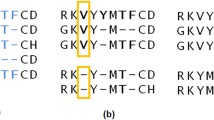Abstract
Multiple sequence alignment (MSA) generally constitutes the foundation of many bioinformatics studies involving functional, structural, and evolutionary relationship analysis between sequences. As a result of the exponential computational complexity of the exact approach to producing optimal multiple alignments, the majority of state-of-the-art MSA algorithms are designed based on the progressive alignment heuristic. In this chapter, we outline MSAProbs, a parallelized MSA algorithm for protein sequences based on progressive alignment. To achieve high alignment accuracy, this algorithm employs a hybrid combination of a pair hidden Markov model and a partition function to calculate posterior probabilities. Furthermore, we provide some practical advice on the usage of the algorithm.
Access this chapter
Tax calculation will be finalised at checkout
Purchases are for personal use only
Similar content being viewed by others
References
Feng DF, Doolittle RF (1987) Progressive sequence alignment as a prerequisite to correct phylogenetic trees. J Mol Evol 25:351–361
Liu Y, Schmidt B, Maskell DL (2010) MSAProbs: multiple sequence alignment based on pair hidden Markov models and partition function posterior probabilities. Bioinformatics 26:1958–1964
Durbin R, Eddy SR, Krogh A, Mitchison G (1998) Biological sequence analysis: probabilistic models of proteins and nucleic acids. Cambridge University Press, Cambridge
Miyazawa S (1995) A reliable sequence alignment method based on probabilities of residue correspondences. Protein Eng 8:999–1009
Thompson JD, Koehl P, Ripp R, Poch O (2005) BAliBASE 3.0: latest developments of the multiple sequence alignment benchmark. Proteins 61:127–136
Edgar RC (2004) MUSCLE: multiple sequence alignment with high accuracy and high throughput. Nucleic Acids Res 32:1792–1797
Sievers F, Wilm A, Dineen D et al (2011) Fast, scalable generation of high-quality protein multiple sequence alignments using Clustal Omega. Mol Syst Biol 7:539
Chang JM, Di Tommaso P, Taly JF et al (2012) Accurate multiple sequence alignment of transmembrane proteins with PSI-Coffee. BMC Bioinformatics 13:S1
Deng X, Cheng J (2011) MSACompro: protein multiple sequence alignment using predicted secondary structure, solvent accessibility, and residue–residue contacts. BMC Bioinformatics 12:472
Vingron M, Argos P (1989) A fast and sensitive multiple sequence alignment algorithm. Comput Appl Biosci 5:115–121
Gotoh O (1990) Consistency of optimal sequence alignments. Bull Math Biol 52:509–525
Notredame C, Holm L, Higgins DG (1998) COFFEE: an objective function for multiple sequence alignments. Bioinformatics 14:407–422
Notredame C, Higgins DG, Heringa J (2000) T-coffee: a novel method for fast and accurate multiple sequence alignment. J Mol Biol 302:205–217
Do CB, Mahabhashyam MS, Brudno M et al (2005) ProbCons: probabilistic consistency-based multiple sequence alignment. Genome Res 15:330–340
Liu Y, Schmidt B, Maskell DL (2009) MSA-CUDA: multiple sequence alignment on graphics processing units with CUDA. 20th IEEE international conference on application-specific systems, architectures and processors, pp 121–128
Thompson JD, Higgins DG, Gibson TJ (1994) CLUSTAL W: improving the sensitivity of progressive multiple sequence alignment through sequence weighting, position-specific gap penalties and weight matrix choice. Nucleic Acids Res 22:4673–4680
Author information
Authors and Affiliations
Editor information
Editors and Affiliations
Rights and permissions
Copyright information
© 2014 Springer Science+Business Media, LLC
About this protocol
Cite this protocol
Liu, Y., Schmidt, B. (2014). Multiple Protein Sequence Alignment with MSAProbs. In: Russell, D. (eds) Multiple Sequence Alignment Methods. Methods in Molecular Biology, vol 1079. Humana Press, Totowa, NJ. https://doi.org/10.1007/978-1-62703-646-7_14
Download citation
DOI: https://doi.org/10.1007/978-1-62703-646-7_14
Published:
Publisher Name: Humana Press, Totowa, NJ
Print ISBN: 978-1-62703-645-0
Online ISBN: 978-1-62703-646-7
eBook Packages: Springer Protocols




